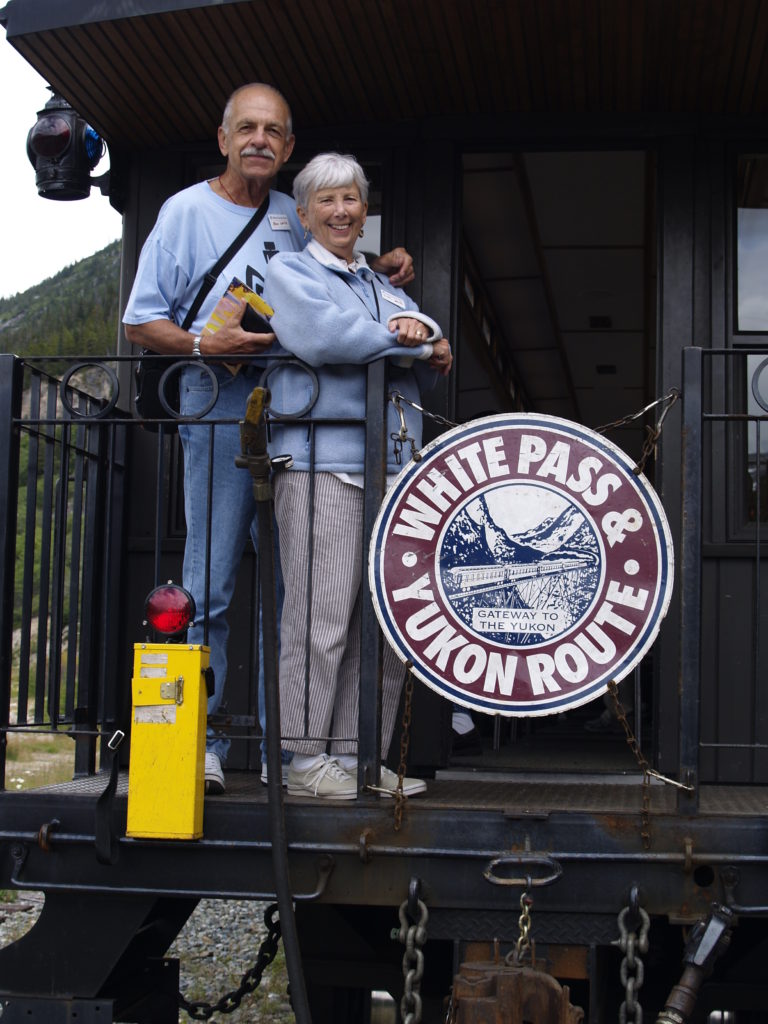
A few months ago I was bustling around the store when our co-worker, Michael(featured in the previous blog post), called me over to introduce me to the lady he was chatting with. He told me she was an avid traveler and backpacker and figured I might be interested in talking to her.
Bless Michael. After only a few minutes of discussion, I knew I wanted to sit down and hear much more about Ruth Ann and her travels. I asked her if she’d be willing to let me feature her and her husband on my blog. She graciously accepted and Jackson and I sat down with the couple at a coffee shop one Friday morning before work.
We hung on this duo’s every word as they shared with us their experiences traveling all over the world, about their time volunteering in National Parks across the country, and about how they want to prove that you are never too old to start chasing your passion.
I did my best to keep the entire interview intact, which makes this a rather long blog post. Please trust me when I say this couple’s story will inspire you to seek adventure, serve the planet, and find the soul that compliments you in the the way that these two do each other.
Me: If you would, just start with your name, where you’re from, and how the two of you met?
Ruth Ann: Well, first of all, we’re both nearly eighty-four. Ruth Ann and Allen White. We met in the 8th grade… But then we went opposite directions after high school. We really never dated… we had one date I think. But really we were just part of a group that hung out together. I think we were unusual at the time. No one in the group really dated. We just went places together, all of us, on our own dime. So, thirty-two years later, his wife has passed away, I’m about to be divorced… and we, we met again at a high school class reunion. I came up behind him and he recognized my voice, with just five words, after thirty-two years of never hearing it. He knew who I was.
Jackson: What were the five words?
Ruth Ann: “This is a voice from your past.” Maybe that’s more like seven…
(Laughter)
Ruth Ann: So we sat and talked around the campfire. We kind of caught up about the past thirty-two years and I made the statement- and this is before the term “bucket list” came into being- but I said one of the things that I really wanted to do was go backpacking. And I told him I loved to hike. He told me much later on that in that moment he’d told himself, “Alright, you better go buy yourself some new boots.” We’ve worn out a few pair since then.
A few might might be inaccurate. Ruth Ann and Allen have trekked through Oklahoma, Colorado, Arkansas, Louisiana, Mississippi, Italy; just to name a few places.
Lindsey: What was your first trip together?
Ruth Ann: Oh goodness. Oh, Mt. Nebo. In Arkansas. ‘Cause it almost didn’t happen.
Allen: (Laughs)
Jackson: Almost didn’t happen?
Allen: (Still laughing)
Ruth Ann: He’s not the most punctual person. He’s much better now.
Allen: Flex time. When I say “about”…
Ruth Ann: He said he’d be over to pick me up, and two hours later he’s still not there and I’m fumin’ mad and I’m about ready to leave the house and just let him wonder where I went… So I was still pretty miffed off, but we went over to Mt. Nebo which is a pretty neat place and we went hiking all around the mountain… that was the first.
Lindsey: So what’s been your favorite since then?
Allen: Hmmm… How about most memorable?
Lindsey: (Laughs) Okay.
Allen: We were backpacking in central Colorado.. There were five of us. While three of us went out hiking one day… well, there were seven of us-
Ruth Ann: Six, six, six.
Allen: Well, we got back to camp-
Ruth Ann: Raining.
Allen: It had rained… and it’s kind of dark, so we went right into our tents… We thought our friends had gotten into their tents, as reasonable people would do. We dry out, warm up, and our friend says- well he calls out for our other friends and nobody answers. So, it’d got to be dark, they were not back, we had no idea where they were; so we broke camp right at dawn and headed down the mountain for search and rescue. So our weekend in the mountains turned out to be rather exciting.. We did learn that search and rescue teams are very effective in how they go about their business.
Ruth Ann: Fortunately our friends had hunkered down, they had some extra food… There were two girls and a guy and they all had a different idea about where they ought to go. So they were completely mixed up and turned around. But they hunkered down and they spent all night under a rain fly. But if they had gone down the hill even thirty yards they’d have come to a cliff and likely fallen over it. Sitting still was probably the best thing for them to do. That was certainly memorable. I don’t think they ever went backpacking again.
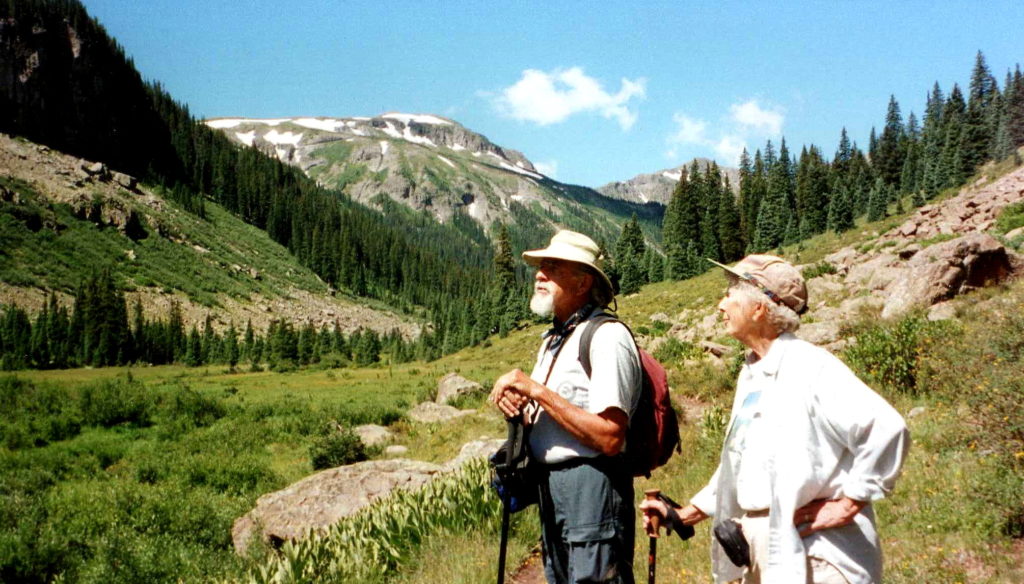
Lindsey: So, what’s the most beautiful place you’ve seen?
Allen: Well I’m thinking… down in The Needles district..
Ruth Ann: Oh.. yeah… ever been in Utah?
Lindsey: For a little bit.
Jackson: Not in The Needles.
Ruth Ann: Canyonlands… It’s the most fascinating place. I’m doing all of the talking here… But I usually do.
(Laughter)
Jackson: Unfortunately the recording doesn’t capture his face.
Allen: Every talker needs a good listener. And I know my role.
Ruth Ann: In The Needles… there’s all these standing rocks and trails that go between them. I can tell you what my initial thought was. We’d hiked about five miles to get to this place. You come up the ridge and through the needles and there’s this huge Chesler Park and there’s trails all over and the grass is probably four feet deep there. I just stood and gasped and said, “If a wooly mammoth stuck it’s head up right now I would not be surprised.” It was that primitive looking. If you ever go there-
Allen: When, when. We want to encourage.
Ruth Ann: When you go there, go to the ranger station, grab a map, and find out where the Joint Trail is. It does NOT simply join two trails together, I’ll tell you that much. But it’s fabulous. Such a surprise. But out in that country, it’s all red sandstone. And you follow the trail looking for cairns about eight inches high. And they’re about fifty yards apart or so, so you’ve got to be scanning, looking for where this goes. Then you’ll come to a place where ancient rivers have carved out of the rock. And there will be a ladder nailed to the wall, and you’ve gotta go down the wall, to the next layer. It’s just, it’s just amazing hiking.
Allen: Oh, I’ve got another… humourous… hike. It was pretty early on. We were out at Bandelier. And Ruth Ann said, “Oh I want to take you to a place… I was here with the girl scouts years ago.” So, we’re going to hike to the Stone Lions. So, off we take down into the canyon and up to the Shrine of the Stone Lions area. And then I say, “Okay, so how do we get back-”
Ruth Ann: No, no wait. You’re way ahead of yourself. There’s loop trails. So I said, let’s go on to- to- oh I can’t remember the name of it. It’s the canyon from the movie Blazing Saddles. But we’re way on around now. Then we come to a crossroads, and then he asks, “Okay, which way do we go now?”
Allen: And her response is, “I don’t know-”
Ruth Ann: “I’ve never been here!”
Allen: “I’ve never been here!”
Ruth Ann: And we didn’t have a map.
Allen: Well, basically we knew we had to go back east from there. So we get back and we drop down into the canyon that the ruins are in. And we know, once we get back there, we parked down near the visitor center. So all we’ve got to do now is hike through the canyon… in total darkness.
Ruth Ann: You might be surprised by how much light there is from stars. That was our only light. No moon, just stars.
Allen: And Ruth Ann is afraid we’re going to get lost. But I say, “No you can’t get lost at the bottom of a canyon… You can’t fall out of a canyon, ya know, you just, if it starts going up you know wait a minute, that’s not the way to get back to where we want to go.” So we’re taking off down the canyon and it was quite dark… she let me go ahead just in case there might be a mountain lion. I should have learned that when you go on a hike with this lady you better carry a headlamp or flashlight, because she’s going to lead you-
Ruth Ann: But he still hasn’t learned.
Allen: No, no… neither of us has.
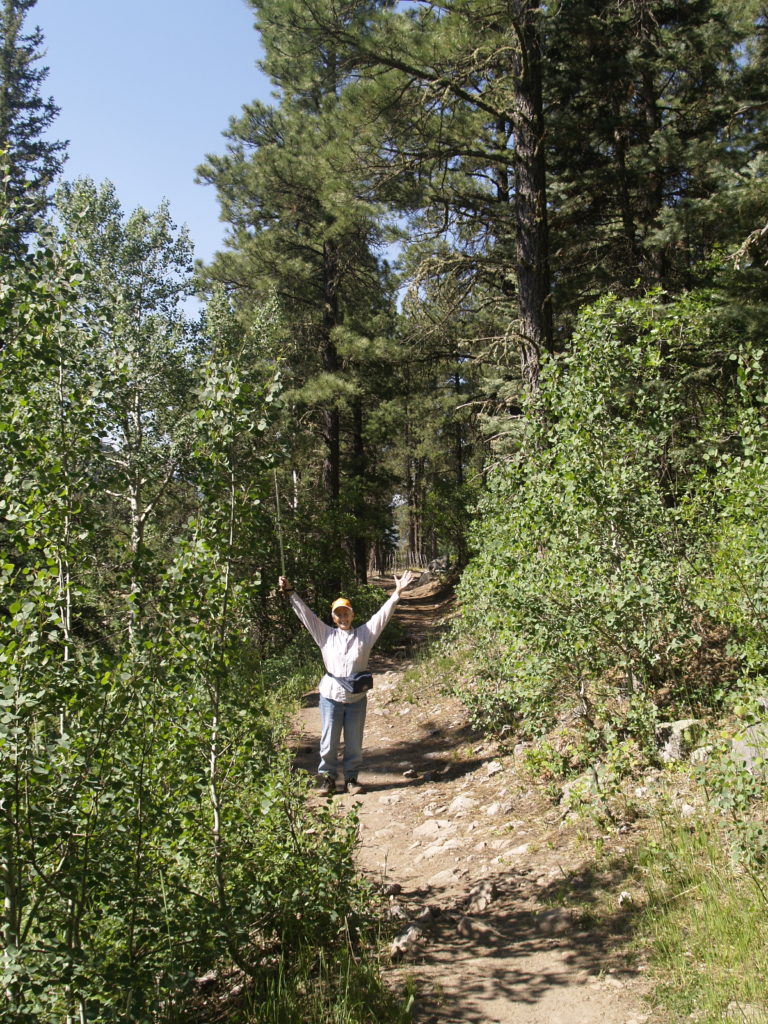
Ruth Ann: We got into one situation, not that many years ago… we’ve hiked a lot of miles in Big Bend and there’s a huge variety of landscapes; high, low, dry. It’s a wonderful place to hike, a lot of history.
Allen: In the springtime or fall; don’t go in the summer.
Ruth Ann: Yeah don’t go in the summer. But late September, October… even in the middle of winter. So we hiked down. Well, to start with, we had been to the bottom of this place; which is a giant chute carved by water.
Allen: Like a pour over.
Ruth Ann: Yeah, yeah a big pour over. It comes down about a hundred to two-hundred and fifty feet into the stream, which is now dry. It’s, it’s this curve, like a chimney. Well we’d been to the bottom of it two or three times and we were thinking, “What’s it like up there at the top?” So there’s a trail and we were going down dry wash, and we get into a big one and we know it’s one of the major places that water comes off the mesa. So we follow that on down. So now we come to this edge and we can see down into a hollow that’s been carved out… but we can’t see the mouth where it goes out. And there’s kind of this slip rock place, going down about twelve feet… well it’s no problem getting down. We slid down. We got over to the opening and crawled to the top. We start waving our hats to the people way down there, ya know, “Hi there!”
Then we thought, I guess we better get outta here. Well it was not so easy getting out. He had to take off his boots. Fortunately, he’s six foot tall, ‘cause I woulda never made it out by myself. But he took off his boots and threw them up on top. He hooked his toes in the little cracks, like a rock climber, and he got up, then laid flat… I could get up about two feet and reach for him… then, with his long arms he pulled me up the rest of the way. We thought, “We could have spent the whole night here…” And again I was worried about a mountain lion! So we haven’t done anything quite that stupid since then!
Allen: Adventurous.
Jackson: Well that’s what they say, the true definition of adventure involves some risk.
Allen: Yes, yes.
Lindsey: So what has been your most challenging adventure?
Ruth Ann: Grand Canyon, for me. We went down on the South Kaibab. It needed a lot of work. This is the one, they take the mules up. So the mules, they grab and they just scoop out everything that’s behind one of the- you know like a railroad tie. So, going down, you step on one of the water bars and- I’m not very long legged. You step down about eighteen inches. Then you’ve got like two steps to the next one, and you have to come up, and down. And up, and down. Up, down, up, down. It seemed like forever. We had a very experienced hiker with us, he had us go off trail, he said maybe a quarter of a mile to camp on the Tonto Plateau. I think he took us a mile and a quarter. My knees were killing me. But, we camped that night and the only light we saw was stars… And the headlights of one car, three thousand feet up.
But then we went on down to Phantom Ranch.. We’re both interested in geology. So we stayed there and camped two nights. We came back out through Indian Gardens, spent a night there. That was the last day, and we just didn’t- well I know now we didn’t have enough calories. But I just flat ran out of energy about a thousand feet below the rim. So our friend came back and insisted on carrying my pack. He said, everyone else is up there and we want to have lunch together before heading home.. So I let him carry it, but it was, rather disgusting, that I had to do that!
We don’t think this experienced trekker had any reason to feel disgusted. Ruth Ann puts in far more miles each year than many people younger than her will in an entire lifetime and she has contributed significant amounts of time and effort to causes that others will reap the benefits of.
Ruth Ann and Allen have each spent over 3,500 hours working for the Forest Service doing archeology, trail building, and historic preservation through an organization called Passport in Time.
Ruth Ann: We worked on a first century A.D. villa storeroom/workroom where they would stomp olives, probably for wine. We were on the East Coast of Italy. The whole purpose of this trip… well the Italians had become familiar with the volunteerism for the National Forest Service here and wanted to start it there. So we took a trip to demonstrate that ordinary people can be trained to do these things and do it right. It was a great trip. We went early and did some stuff on our own and then met the group. There were about fifteen to twenty of us. We worked for two weeks, off and on. We were entertained royally because San Salvo wanted to get more tourism going. So, I don’t know if we were any good at convincing the Italian government to use more volunteers but we had a great time doing it!
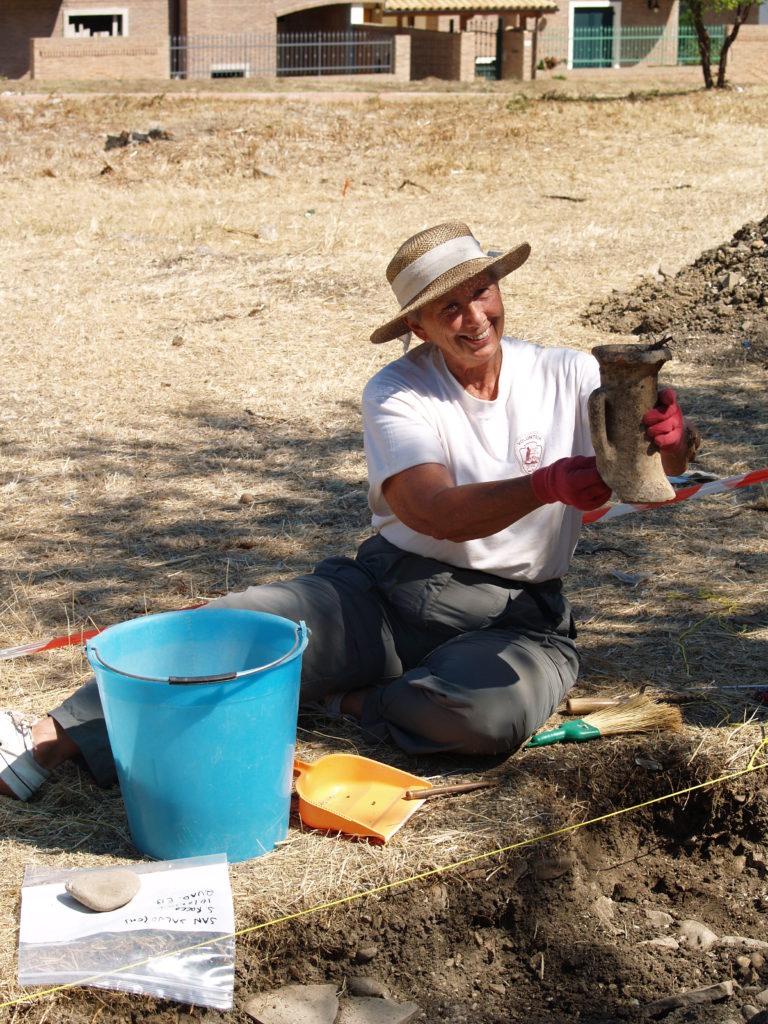
Lindsey: I’m sitting here thinking we need to plan a trip centered around volunteering…
Allen: Well, I would tell you another one then.This one was an early Roman- around 44 A.D. – project.
Ruth Ann: By this time we were sixty-seven.
Allen: So we worked there and it was pretty interesting. Ruth Ann is a- a curious person. She saw this mound in the center of the area where we were working. She asked the leader, “Well why aren’t we working in that mound?” He replied, “Well, that mound was previously excavated-” Are you ready to take over now?
(Laughter)
Allen: She’s chomping at the bit.
Ruth Ann: Well, this was the Roman officer’s bathhouse. It was absolutely full of mosaics. So I was just itching to get a hold of it. I thought, Why aren’t we digging there? “Well it’s been excavated before… in 1776.” Does that ring a bell?! They’re doing archeology in England and we were just becoming a country! I’m sure my jaw dropped.
Allen: My reply was, “Well, obviously you should have spent a little more time paying attention to the colonies instead of playing in the dirt here. See what happened?”
Jackson: So, you went back and took archeology classes. How old were you when you did that?
Allen: Fifty. In Tulsa, in the late 40’s, in the eighth grade they had an event called Career Day. And they asked, “What do you want to do when you grow up?”
Ruth Ann: For the rest of your life. When you’re fourteen!
Allen: Well, even in the eighth grade I thought it was a dumb question to be asking so early. I thought, Well I don’t know. And so the counselor looked at my grades to date and said, “What are your favorite courses, Allen?” And I said, “History and geography are my favorite courses.” She looked and said, “Yes, that’s right, but the only thing you can do with history or geography is be a teacher and they don’t make much money.” Now that registered with an eighth grader. She said “much money” and even by the eighth grade you can understand you want more money. So, then she says, “Well, you’re also good in math and science, so you should be an engineer or scientist and help us defeat the communists.” So I said, “Well, I’ll be an engineer. I don’t want to wear a white coat and be locked up in a tower by myself all day.” Fast forward a few decades, my wife has died and my daughters are off doing their thing. And I have time. So I remembered back to the eighth grade and decided I would go back to what I like the best. So I now have a junior college degree in history and geology.
Jackson: So what do you want to be when you grow up?
Allen: I’m still working hard on NOT growing up. I feel sorry for anyone who has “grown up.” They miss so much. There’s so much to learn and to do if you will just look around.
Ruth Ann: There is absolutely no reason for anyone to ever be bored. There are too many things to do. You can’t live long enough to do all the things we want to do. I don’t want to be thirty-five again. I want to be sixty-two again… That’s my retirement age. I want to have that many more years now to backpack. Volunteering started for us, with the idea…We had hiked and been on trails that were maintained by volunteers. And we thought, it’s time to give back. The more we did, we realized, the benefit was for us… It was for the country and the individual states, but we were getting so much out of it. We’d been into places that the average person was never going to see because it was restricted. But because we were with a leader doing a project in that area we got to go there. Around Lake Powell, there’s a trail that goes under and behind Bramble Bridge. It goes through a gate and you’ve got to have permission from the Navajo Nation to get there. It’s right under their sacred mountain. The reason it became protected by the federal government is because Teddy was led fifteen miles down a trail, long before the lake was there, and he spent the night there. His bed springs are still there. We got to go in there because we were working to clean up trash around Lake Powell! So we’ve done that seven times. So you just, you get to go a lot of different places. But I think, having enthusiasm and curiosity and getting excited… those are the main ingredients. It’ll take you anywhere. Just last September, we did our 25th project in the Picket Wire Canyons of southeast Colorado, working on what will soon be the biggest dinosaur trackway in the world. And we’ve uncovered most of it, us and our group of volunteers. I can show you a footprint that I uncovered in September, that no human had ever seen until I did. It had been there one-hundred and fifty-five million years, undisturbed. I get chills!
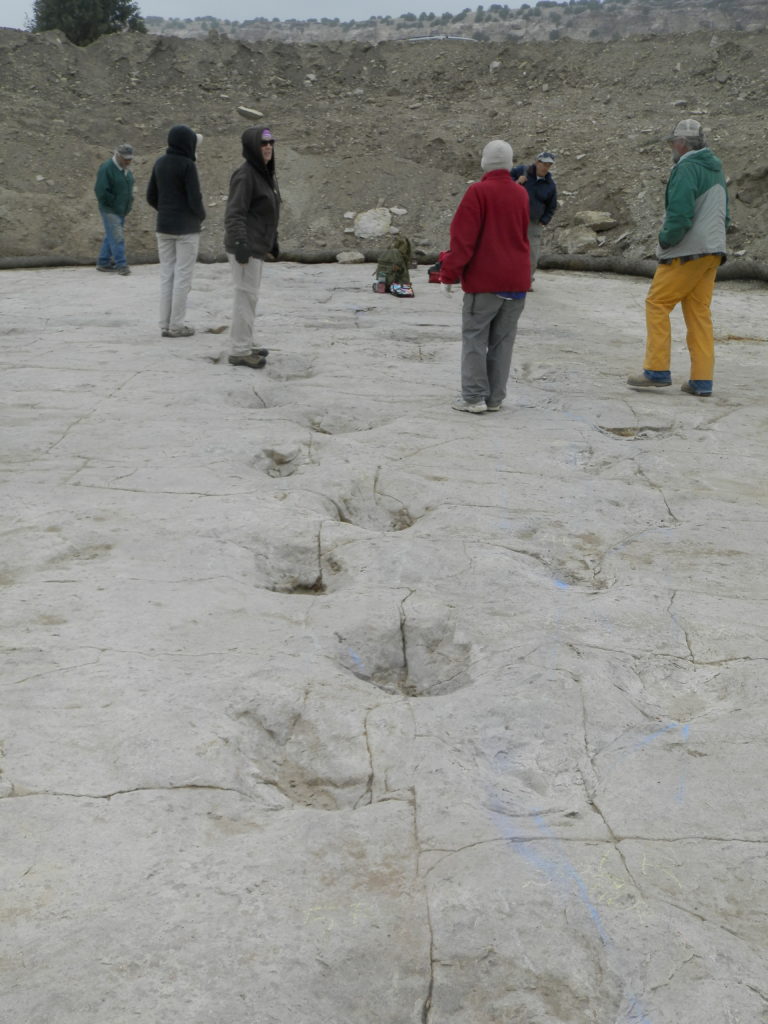
Lindsey: That’s incredible! Tell us about your first volunteer project.
Allen: The first string of volunteer projects… Ruth Ann and I were headed back home from New Mexico and, and we’d picked up a New Mexico magazine… and there was a little paragraph about how the Forest Service has this volunteer program and in general they’d help the forest service maintain the historical aspects in the many national forests, if you’re interested in more information contact this address… So we got home and I fired an email that I’d like to know more about that. I was laid off on a Friday, they thought they’d laid me off, but I just took an early retirement. On Monday came the information on Passport in Time and a whole list of projects. I got real excited and applied for one. They said they were sorry but that one was full. So I called the number and said well that project is full but surely there’s one that isn’t. They said yes there’s this one, but you’ll have to call the leader because it’s past the time for applications. So I called and he accepted me. It was in the mountains of central Utah. I was pretty excited, but Ruth Ann was a little miffed because I had retired before she had.
Ruth Ann: Which wasn’t supposed to happen!
Allen: I called her at work to give her the good news because I thought she’d be as excited as I was. She listens, and I don’t know if you’ve ever been on a telephone when suddenly there is just stony silence. And you can feel energy being sucked into the telephone. And I hear, “I’m happy for you.” I could hear teeth gritted!
Ruth Ann: (Laughing) It wasn’t fair!
Allen: But that started the string of volunteer projects. I’ve done one hundred and one projects since retirement at the age of sixty-one.
Ruth Ann: I have to say a word about Passport in Time because it’s been the main organization we’ve worked with. Congress mandated the Forest Service to identify and preserve anything of historic value within the National Forest. But of course they gave no money to do it with. And there are many many many historic structures and trails across mountains. Passport in Time has so many opportunities across the United States, and there aren’t as many now because the Forest Service does have to fund a certain amount of the expense for tools and supervision. And they keep getting starved by the federal government… and then the president blames them for the forest fire… because they haven’t been given any money to go out and rake all the leaves… excuse my irony there. But they’re caught between a rock and a hard place all the time. But a couple up in Michigan I believe, were the first to see that the forest service really needed volunteers. They started it and it grew to over 2,500 during the height of it’s operation some years back. And there’s, there’s something for everyone. Truly.
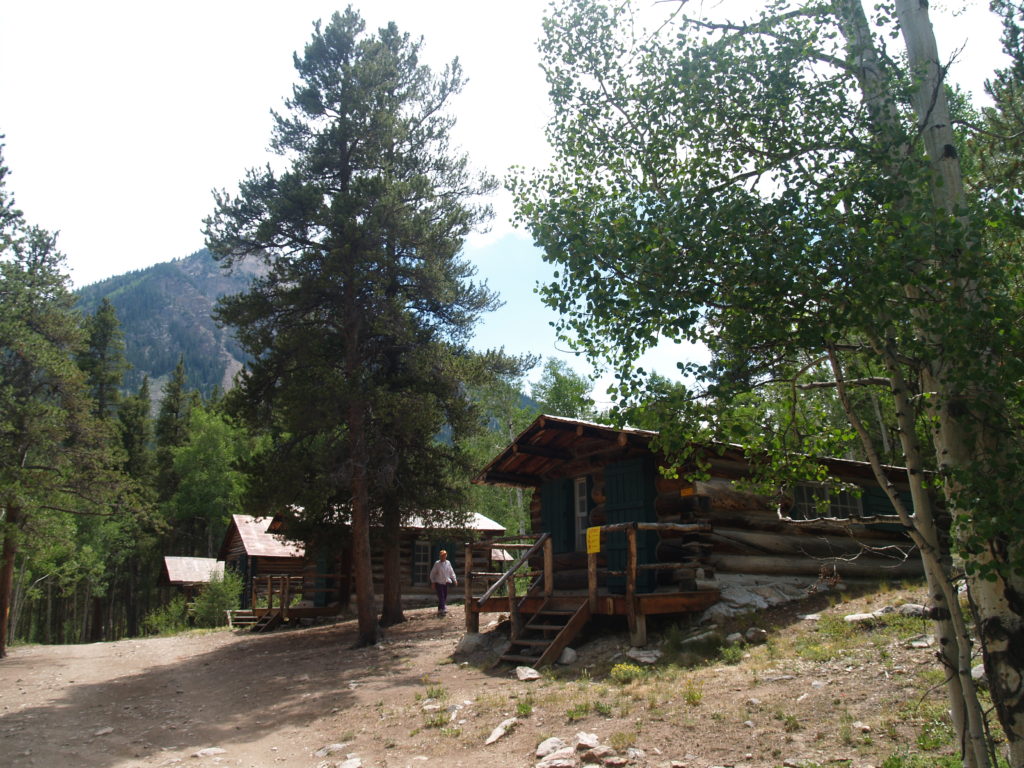
Jackson: So, y’all have touched on this a little bit, and Lindsey explained the blog, how it’s about people who are in the in-between stage of life; not wanting to grow up, not knowing what to do, not knowing their place in the world…
Allen: Look for it! Searching is a great adventure… some people see it as a problem. I would encourage them to look at it as a great learning experience. Go out and search for yourself whenever you can and wherever you can. You will find elements of yourself in these places. And if you’re fortunate, you’ll never get through.
